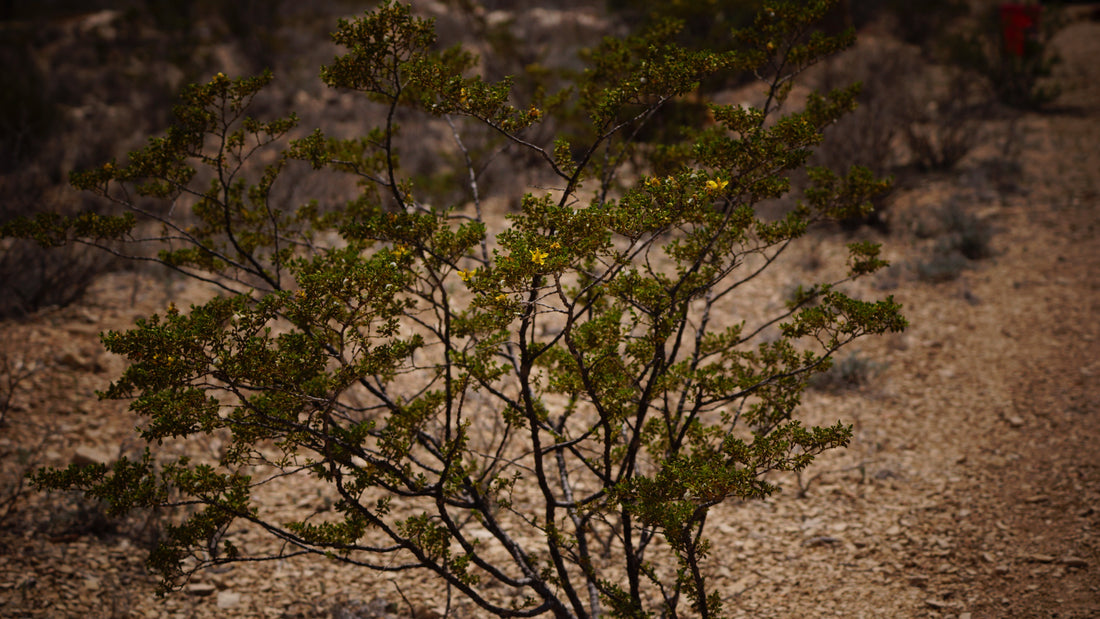
How To Make Creosote Salve
Share
How To Make Creosote Salve
DIY multi-purpose skincare has never been so easy (just 3 ingredients)
Keep reading to find out why you need creosote salve and how to make it!
The Creosote Bush is known throughout the American Southwest and Northern Mexico for its nostalgic scent, a desert rain.
And just to get it out of the way, it is not to be confused with toxic creosote coal tar!
The creosote bush is a low-lying shrub found in the Mojave, Sonoran, and of course the Chihuahuan Desert (home sweet home!) Humans are pretty much the only ones who utilize its potent benefits.

As far as natural predators go, it doesn’t taste very good. So except for the occasional hungry Jack Rabbit it’s mostly passed over. It had a predator,the American Camel. Unfortunately, no one has seen one of those in a long, long time. (About 11,000 years!)
The reason the leaves of the Creosote Bush taste so bad is because they are protected with a waxy resin. It’s this resin that gives Creosote Bush its beneficial properties.

There’s a reason it’s an evergreen even with almost no rainfall!
The bush effectively stores water and concentrated nutrients to get it through the longest droughts. Interestingly, one of the oldest known living organisms on Earth is a ring of creosote bushes. It dates back to 11,700 years old!
Creosote Bush has been recognized for its healing properties for ages.
And when used medicinally, creosote is often referred to as Chaparral.
One of the active compounds found in the bush is called NDGA (Nordihydroguaiaretic acid.) This naturally occurring compound has been studied to be 100x MORE effective than vitamin E!

Creosote Salve Uses
While we can’t and don’t recommend ingesting it orally, we do have a lot of experience making it and using creosote salve topically...
Here's the many ways creosote salve comes in handy:
Creosote Salve for eczema relief

Creosote Salve for bruising and scrapes

Creosote Salve for sunburn relief

Creosote Salve for tattoo healing

Creosote Salve for bug bite relief and soft feet

Creosote Salve for dry chapped hands

Creosote Salve for bites, burns, blisters, and splinters!

I'm sure you get the point! Creosote Salve is an incredible remedy to have on hand.
Creosote Salve or Chaparral Salve Benefits
- Promote healthy, glowing skin thanks to potent antioxidants like NDGA
- Soothe and protect minor scrapes and abrasions with its natural anti-bacterial and anti-fungal properties
- Reduce inflammation from sun exposure to sore muscles
- Heal dry, cracked skin
- Provide long-lasting hydration
- Replenish your skin’s natural skin barrier
- Alleviate itchy skin, from bug bites to rashes
- Soften and reduce fine lines and wrinkles
- And so much more!
Without further ado, here is how anyone can make Creosote Salve at home!

Creosote Salve Recipe
You can make homemade creosote salve with as little as 3 ingredients!
What you’ll need:
1 cup of Creosote leaves (dried is okay!)
8 liquid oz of high-quality oil (any carrier oil is great. Some of my favorites are extra virgin olive oil, sunflower oil, and avocado oil)
~2oz of beeswax (this is dependent on how firm or soft you’d like the final salve to be)
A glass jar and lid (A little larger than 8oz to fit the oil and leaves)
Strainer
Double Boiler
5, 2oz tins (this will make ~10oz of salve
How to make it:
- Add 1 cup of creosote leaves to a glass jar. Don’t forget to take a whiff of that lovely, natural scent of rain! Then, pour 8 liquid oz of your choice of oil over the leaves. Make sure to fully incorporate it so the oil has as much contact with the leaves as possible. Label with the date, and set aside for at least two weeks, away from direct sunlight.
- Once the two weeks are up (or up to 6 months for a deeper scent), pour oil through a strainer into the pot you’ll make the salve in. Discard leaves. Heat in a double boiler with ~2oz of beeswax. Once melted and fully incorporated, pour into your tins/jars!
- You’ll want to wait until the salve has fully cooled to put lids on. Our salve (Terlingua Rain) has a shelf-life of 2 years (and counting)! So, your salve should last quite a while if you were able to dodge contaminants and water.
In no time you’ll be soaking in the potent, soothing effects of your homemade creosote salve!
Don’t want to make it? Check out our sustainable, non-toxic, handmade creosote salve here!
Once you’re comfortable making salve, feel free to play around with the recipe! You can have fun mixing up your wax base and using different oils.
Weather, like humidity and heat, can affect the extraction process and the finished salve.
Drop a comment below, I’d love to hear how your salve came out!
Want to know more? Check out our blog here.
For a comprehensive breakdown of the benefits of creosote salve or chaparral salve, check out:

